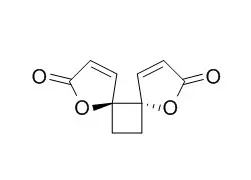| Description: |
Anemonin, a naturally occurring selective iNOS inhibitor, it has potential anti-inflammatory effect; it is also a potent protective molecule for osteoarthritis, it delays osteoarthritis progression by suppressing ECM loss and chondrocyte hypertrophy partially by suppressing IL-1β/NF-κB pathway activation. Anemonin can alleviate nerve injury after cerebral ischemia and reperfusion (i/r) in rats by improving antioxidant activities and inhibiting apoptosis pathway.
Anemonin inhibits melanin synthesis by inhibiting the transcription of the genes encoding MITF, TYR, TRP1, and TRP2. |
| Targets: |
NOS | IL Receptor | NF-kB | MMP(e.g.TIMP) | MITF | TYR | TRP |
| In vitro: |
| J Dermatol Sci. 2008 Feb;49(2):115-23. | | Anemonin is a natural bioactive compound that can regulate tyrosinase-related proteins and mRNA in human melanocytes.[Pubmed: 17766092 ] | Melanin is the pigment responsible for skin color. Melanin synthesis occurs with the participation of the tyrosinase (TYR) family of proteins including TYR, tyrosinase-related protein 1 (TRP1), and tyrosinase-related protein 2(TRP2/DCT).
The effect of a newly isolated natural compound that inhibits hyperpigmentation on the regulation of the TYR family of proteins was examined.
METHODS AND RESULTS:
The natural compound, anemonin, was isolated from Clematis crassifolia Benth and was used to inhibit cellular TYR activity; it was found to have a low cytotoxicity (cell viability > 80%) in human melanocytes.
In human melanocytes, anemonin showed both time- and dose-dependent inhibition (IC(50) 43.5 microM) of TYR. Western blot analysis and immunocytochemical staining revealed that expression of TYR, TRP1, and TRP2 was decreased in anemonin-treated melanocytes. Additionally, reverse transcription and quantitative real-time polymerase chain reaction analyses revealed that expression of mRNAs for MITF, TYR, TYRP1, and TYRP2 was also suppressed by anemonin.
CONCLUSIONS:
The natural compound, anemonin, an active compound of C. crassifolia, inhibits pigmentation synthesis in human melanocytes. Anemonin inhibits melanin synthesis by inhibiting the transcription of the genes encoding MITF, TYR, TRP1, and TRP2. This natural compound may be a candidate for cosmetic use. | | J Ethnopharmacol. 2008 Mar 28;116(3):518-27. | | Anemonin, from Clematis crassifolia, potent and selective inducible nitric oxide synthase inhibitor[Pubmed: 18281171 ] | The aim of this study was to examine the anti-inflammatory effects of aerial part of Clematis crassifolia Benth. (Ranunculaceae) based on an iNOS inhibition in lipopolysaccharide (LPS) activated macrophages.
METHODS AND RESULTS:
Bioassay-guided fractionation and purification led to the isolation of ibotanolide B (1), calceolarioside B (2), trans-caffeic acid (3), anemonin (Anemonine,4) and 3',4',5,7-tetrahydroxy-6-C-glucopyranosylflavone (5). Their structures were elucidated on the basis of spectroscopic analysis. All these compounds inhibited NO production, detected as nitrite, in activated macrophages except 5. Among them, anemonin (Anemonine,4) was the most potent. Analyses of reverse transcription-polymerase chain reaction (RT-PCR) and Western blotting revealed that it decreased the expression of iNOS mRNA and protein in activated RAW 264.7 cells. In isolated rat thoracic aortic rings, anemonin(Anemonine) prevented the vascular hyporeactivity to phenylephrine induced by LPS whereas it did not affect acetylcholine-induced endothelial NO-dependent relaxation, an index of endothelial NOS (eNOS) activity.
CONCLUSIONS:
These results indicated that the potential anti-inflammatory effect of anemonin(Anemonine), the naturally occurring selective iNOS inhibitor, may provide a rationale for the medical use of Clematis crassifolia. |
|
| In vivo: |
| J Mol Neurosci. 2014 Jun;53(2):271-9. | | Anemonin alleviates nerve injury after cerebral ischemia and reperfusion (i/r) in rats by improving antioxidant activities and inhibiting apoptosis pathway.[Pubmed: 24443273 ] | In the present study, we aimed at evaluating the potential neuroprotective effect and the underlying mechanism of anemonin against cerebral ischemia and reperfusion (I/R) injury.
METHODS AND RESULTS:
Anemonin was administered to rats by the intraperitoneally (i.p.) route once daily for 7 days before middle cerebral artery occlusion (MCAO). Focal cerebral ischemia was induced by 90 min of MCAO followed by 24 h of reperfusion. After that, animals were sacrificed by decapitation, brain was removed, and various biochemical estimations, neurological status, and assessment of cerebral infarct size were carried out. MCAO followed by 24 h of reperfusion caused a significant increase in infarct size, neurological deficit score, malondialdehyde (MDA) content, reactive oxygen species (ROS) level, and DNA fragmentation, as well as a decrease in the activities of superoxide dismutase (SOD), catalase (CAT), reduced glutathione (GSH), glutathione peroxidase (GPx), and Na(+), K(+)-ATPase in the brain. Furthermore, elevated Bax expression, increased caspase-3 cleavage, and decreased Bcl-2 expression were observed in nontreated rats in response to focal cerebral I/R injury.
However, pretreatment with anemonin significantly reversed these levels of biochemical parameters, reduced cerebral infarct size, and improved the neurologic score in cerebral ischemic animals. Additionally, a wide distribution of anemonin in plasma and brain tissues and the brain-to-plasma partition coefficient (Ri) ratio of 0.7 at 90 min indicated that this compound could penetrate the blood-brain barrier (BBB).
CONCLUSIONS:
These results showed that pretreatment with anemonin provided a significant protection against cerebral I/R injury in rats by, at least in part, its antioxidant action and consequent inhibition of apoptosis. |
|






 Cell. 2018 Jan 11;172(1-2):249-261.e12. doi: 10.1016/j.cell.2017.12.019.IF=36.216(2019)
Cell. 2018 Jan 11;172(1-2):249-261.e12. doi: 10.1016/j.cell.2017.12.019.IF=36.216(2019) Cell Metab. 2020 Mar 3;31(3):534-548.e5. doi: 10.1016/j.cmet.2020.01.002.IF=22.415(2019)
Cell Metab. 2020 Mar 3;31(3):534-548.e5. doi: 10.1016/j.cmet.2020.01.002.IF=22.415(2019) Mol Cell. 2017 Nov 16;68(4):673-685.e6. doi: 10.1016/j.molcel.2017.10.022.IF=14.548(2019)
Mol Cell. 2017 Nov 16;68(4):673-685.e6. doi: 10.1016/j.molcel.2017.10.022.IF=14.548(2019)